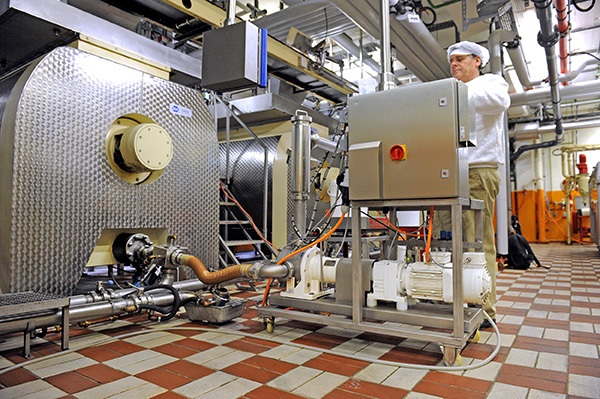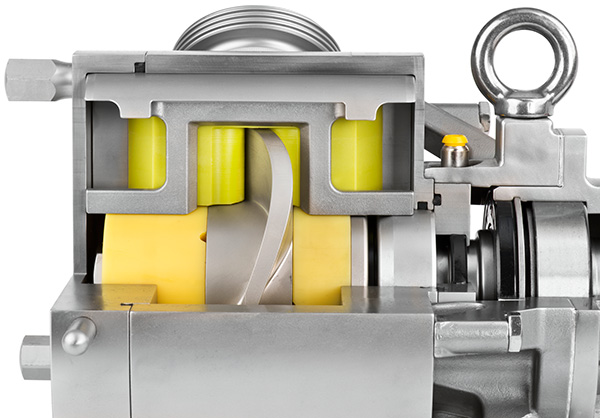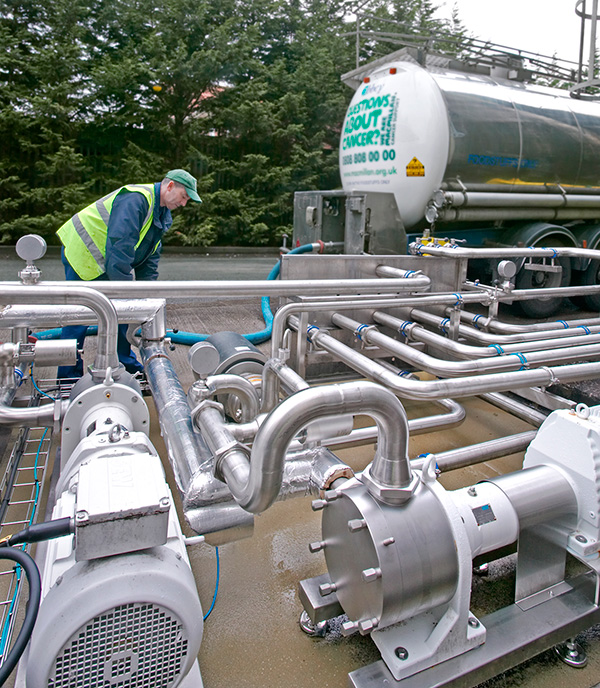During the past 30 years, sine pumps have developed to meet the food and beverage industry need for a pump that is simpler, gentler and more reliable than traditional positive displacement pumps. Sine pumps are characterized by a sinusoidal rotor that creates four separate and symmetrical pumping chambers within the pump. The undulating action of the turning rotor gently transfers product. Without the arduous fluid path and pulsation that is characteristic of other technologies, sine pumping delivers constant volumetric displacement while eliminating product compression and minimizing damage to large particles or shear sensitive products.
These capabilities make sine pumps ideal for food and beverage applications. Whether pumping thick or shear sensitive products, the large, open cavities ensure that food is not damaged during transfer.
 The gentle, low shear product-handling capability of the sine pump is key to its success in confectionery applications. (Images courtesy of Watson-Marlow Pumps Group)
The gentle, low shear product-handling capability of the sine pump is key to its success in confectionery applications. (Images courtesy of Watson-Marlow Pumps Group)Maintenance & Cleaning
Because they feature a single shaft and single rotor, sine pumps are also relatively easy to maintain. With few parts, sine pumps can be completely overhauled in line, often within minutes. Compare this with the two sets of rotors, seals and complex timing gears found in conventional rotary lobe or circumferential piston pumps. Sine pump users can also eliminate the costly process of returning pumps for complex rebuilds or the remachining of pump housings, maintenance procedures that many rotary pumps require.
In addition, many sine pumps can be cleaned in place (CIP) and offer various CIP modifications depending on the pumped product and cleaning protocol. Many sine pumps are also certified to 3-A sanitary standards. For users not equipped to handle CIP procedures, sine pumps can also be quickly and easily disassembled, cleaned and reassembled for cleaning out of place protocol.
Costs
The costs associated with poor equipment selection, which often lead to long periods of plant or line downtime, can be crippling. A comprehensive view of the total cost of ownership will deliver major benefits to the food and beverage processing facility.
While positive displacement pumps can be more costly than other equipment, end users must realize that the cheapest pump is not always the least costly in terms of product quality, maintenance, installation or system integration process. Overall pump performance, energy efficiency, reliability and suitability for the application are all factors that influence total cost of ownership and make positive displacement sine pump technology a cost-effective option.
 The sine single-rotor design provides zero pulsation while large pumping chambers maintain product integrity.
The sine single-rotor design provides zero pulsation while large pumping chambers maintain product integrity.4 Case Studies
The following four case studies exemplify how positive displacement sine pumps can be ideal for the food and beverage processing industry.
1. A poultry processor recently switched to a sine pump for transferring its marinated boneless breast meat and is now reaping the benefits. Previously, the plant used vacuum and air pumps to transfer the product into a drop hopper, which attempted to meter the product on to the conveyor. Neither the vacuum nor air pump proved to be efficient. Both provided only slugs of product to the line, flow rates were inconsistent and product had to be spread manually onto a lengthy conveyor, leading to significant marinade losses.
After two sine pumps were installed, the roasting line was almost labor-free, and the plant saw near-zero losses.
2. A facility in the dairy sector needed to transfer curd cheese. With the introduction of sine pumps, the facility was able to significantly reduce curd damage, which resulted in fewer fines lost to the whey stream. This efficiency improvement increased the cheese yield and improved the quality of the final product. Because undamaged curd absorbs dressing more uniformly and requires less dressing, the sine pumps helped to drastically improve the appearance, consistency and quality of the stirred curd products. The customer has also reported an overall improvement in plant efficiency, reduced downtime and greater productivity.
 Sine pumps reduce offloading time from tankers compared with alternative pump technology.
Sine pumps reduce offloading time from tankers compared with alternative pump technology.3 A candy manufacturer chose sine pumps to transfer a chocolate that contained nuts and crisped rice. The sine pumps prevented shear to the product, and the pumps’ powerful suction minimized hydraulic problems with their long suction runs. These characteristics eliminated recurring costly system damage associated with water hammer and pump cavitation.
4 Positive displacement sine pumps have become the technology of choice for the fast-growing ready-to-pour and frozen concentrate market segments. The multiple phases of juice processing—including loading and unloading of the tankers that transport the concentrate—require superior speed of transfer, powerful suction, low shear and low pulsation. Sine pumps transfer concentrate to a blending process, where the end product is ready-to-pour juice, or to a filler for packaging as frozen concentrate.


